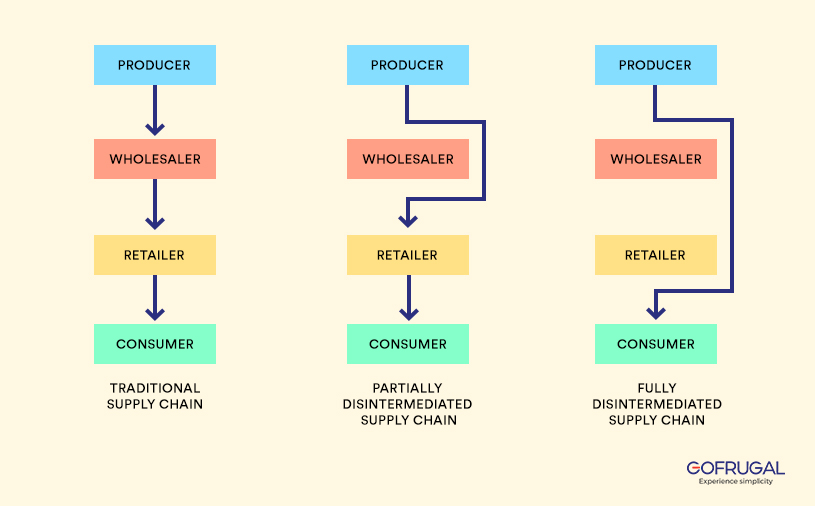Are you a distributor or a retailer struggling to sustain your position in the supply chain?
You are not alone. In the last decade, manufacturers have started to sell directly to consumers, causing disintermediation in the supply chain. Almost half (48 percent (source: Bringg)) of the manufacturers are considering direct-to-consumer channels, subjecting the intermediaries to danger. In other words, almost 50% of the demand has disappeared with the same supply, highly increasing competition between the intermediaries.
Here is a clear picture of how the supply chain has been modified due to the concept of direct dealing.

So, how did disintermediation start in supply chains?
Manufacturers want better margins and consumers want access to products as soon as possible. By eliminating the intermediaries, sellers get margins that they were never able to get when the products were passed between multiple intermediaries.
Traditionally, the intermediaries act as a communication channel between sellers and buyers. This was convenient for both these parties as communication and transactions would have been nearly impossible.
What if there was a portal that connected sellers directly with consumers? Sounds easy, right?
This is exactly what e-commerce did, which is where it all started.
From smartphones to AI-driven bots, technology has transformed the way we live. With abundant resources available online, it is becoming easier and easier to carry out major activities from remote locations. Technology, like every other marketplace, has acted as a catalyst in the process of disintermediation in the supply chain.
A closer look

Manufacturers started selling directly to end-consumers via online platforms. With higher margins and direct contact with consumers with feasible infrastructural costs, the model started attracting more manufacturers.
According to data from MDM distribution e-commerce survey (source: mdm), more than half of manufacturers said they are using e-commerce to sell to end-users. 64% of consumers buy directly from manufacturers and 88% of them are likely to increase their purchases from manufacturers. Hence, increasing direct sales has put distributors in danger.
The main question is, how can you fight disintermediation?
1. Premium customer experience
In today’s world, customers expect a smooth and seamless journey. If they do not receive the same from vendors, they move to the next without hesitation. Organizations are starting to adopt a customer-centric approach, in which the customers’ needs come first. Distributors and retailers are no exception to this fact. Yes, your competition is striving to deliver a premium experience to its customers.
Hence, to survive in this highly competitive market, it is essential that you bring your ‘A GAME’.
The first step in delivering good customer experience is understanding your customers’ needs and behaviour. With unlimited data on customer purchase history and frequency gap of procurement, you can ensure a personalized purchase experience.
Secondly, it is important to give them a valid reason to choose you, over your competitors. You can choose from a variety of differentiators, such as, ease of ordering, lower processing time, offers and discounts, whichever suits you and your customers best.
2. Insight-driven approach

Consumer behaviour varies from place to place and from product to product. Understanding customer trends, specific to regions, and decision-making burdens the suppliers. Therefore, audiences need to be segmented based on regions, products, behaviour and many other factors.
When manufacturers increase direct sales, they will have to take over the services that were carried out by the distributors and retailers traditionally. Manufacturers that have only been dealing with distributors, will have to build their own client base. The investments in infrastructure and resources required to manage the entire consumer base are high. Moreover, aggressive market segmentation and research are necessary to understand each market segment.
However, distributors and retailers are in close contact with a specific region and the customers. This makes it much easier for them to understand market trends, customer needs and expectations.
With technology making it possible to derive business insights from mobile applications, it is time for intermediaries to have an insight-driven approach to selling. As they have easy access to customer behavioural data, it can be used in deriving actionable insights. This data-driven approach helps manufacturers take informed decisions on production and distributor for each market. Not to mention, you become a valuable resource to them.
3. Technology to fight technology
In the era of automated warehouses and delivery drones, we are all fighting a battle with technology every day. What better way to fight technology than with technology itself, right?

Opt for a simple, all-in-one business management system that will help you manage your operations better. A solution empowers you with complete control over inventory, customer information and loyalty management. Spend time developing strategies to grow your business rather than on manual work.
In order to survive in the digital era, it is time for retailers and distributors to equip themselves with powerful tools and get all the help they need. By making the right use of technology and innovation, you can not only overcome supply chain disintermediation but become an inevitable part of the chain.
